
13 minute read
GOING GLOBAL
South African Shoprite and French chain Carrefour.
• Shoprite – this South African chain has maintained its position as a premier retailer in Africa, but it made headlines when it announced its exit from Nigeria in August 2020. Who walks away from 25 stores in Africa’s largest economy with over 200 million people? Someone whose business keeps on running into logistical nightmares while moving merchandise into the country or whose pricing is exorbitant for the locals or both. Shoprite is very expensive outside South Africa; in its home country it is a bargainhunter’s dream. My visit into one of its Kampala branches one day in 2007 shocked me as the prices looked like those one would expect at Woolworths, which also exited
Nigeria. Problems arise when South
African exports incur high costs and suffer immense inconvenience at ports of entry, where some officials demand bribes. This is a missed opportunity to indigenise their supply chain in whatever country they operate in by procuring from local suppliers or training them to meet their standards, if that is the problem. The sense of belonging through shared benefits as proposed by the BearingPoint document is missing due to this over-South
Africanisation of retailers outside their home country.
• Woolworths – when this high-end retailer left Nigeria in 2014, the same question was asked: what does its move say about Nigeria?
The move says something about
Woolworths, not Nigeria. The problems cited, including high rentals, were indicative of a more fundamental problem. FMCG in
Africa is a price-sensitive play. Why would Nigerians with cash, who can shop in London, pay top dollar for
Woolworths’ goods? This is not to say Woolworths’ goods are not worth their price, but, in the context of what a rich Nigerian would rather do, entering Nigeria was a miscalculation by Woolworths in the first place, unless the retailer had a strategy to price its merchandise differently to make the rent, at least.
The BearingPoint document mentions a few anecdotes of how retailers can make it in African countries, including the following:
Stronger customer loyalty and a sense of belonging
• Jumia is a pan-African e-commerce player that has found a way around the challenges facing brick-andmortar stores in Africa; creating its ‘own logistics marketplace to leverage third party companies and self-entrepreneurs for city-to-city and last-mile deliveries’, offering its services to ‘other retailers as a white label’. White labelling involves the selling of goods by a retailer (using its own branding and corporate identity) with the help of a third-party manufacturer. Pick n
Pay has been known to market its
‘No Name’ brands, hotels use detergents under the same arrangements, and many restaurants sell ketchup and relish carrying their own labels to sell goods made or supplied by a third party. One wonders if Shoprite and Woolworths would have considered partnering the likes of Jumia in Nigeria?
• When a large retail chain enters an
African market, it is up against social media-based solutions such as
TradeDepot, which is a platform for very small companies to enable them to put their products on the web.
Competing in a country like Nigeria, against very small traders with knowledge of the back alleys of the city offering affordable alternatives using a social media platform, could be suicidal for a foreign retailer – unless such a retailer can find ways to integrate the very small traders into their value chain or use the same social media to reach and serve its customers.
• At the end of 2015, sixteen countries in the world (fifteen of which were in sub-Saharan Africa) had opened more mobile bank accounts (M-Pesa,
Wizzit, Jumia or Konga) than traditional bank accounts. With over 30 million customers by 2017,
M-Pesa and its peers would force retailers to find better ways to process payments, including transactions such as buying an airline ticket. Without this form of adaptation or partnership, retail in
Africa will remain mission impossible.
These are but few examples of how every retailer is operating in a continuously evolving market on the continent and has to keep on adapting to grow or effectively die. The fact that star performers like Uchumi and Nakumatt are all but history in a space of less than five years of flourishing proves that no one is guaranteed survival unless they innovate and continuously improve, including digitalisation.
IN CONCLUSION, A WORD FOR THE INFORMAL SECTOR
The various FMCG companies and retail chains form part of the FMCG fabric of the African economy. Just as in some cases more than 80% of food production in African countries is the responsibility of small-scale farmers, the informal sector plays a crucial role in Africa’s FMCG and retail sector. Most economies in Africa and other emerging markets are dominated by the informal sector. For example, a 2018 study of the Ghanaian economy states that there has been an upward trend in the size of the informal
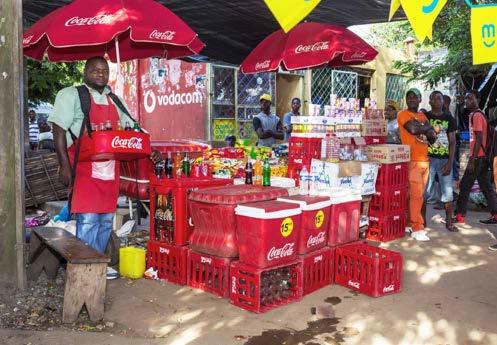

›It’s not unusual for companies to share infrastructure. For example, the efficient distribution machinery of Coca-Cola is used to deliver pharmaceuticals in some remote areas.
economy as a proportion of the officially recorded GDP; from 14% in 1960 to 18% in 1977. Although this fell for a while, it picked up again from around 1983 to reach 30% in the 2003/2004 period.
Some of Africa’s most innovative solutions like M-Pesa did not grow as a result of agents operating out of glitzy shopping malls, but rather as informal businesses in the back alleys of areas underserved by the formal financial system. This was a result of their responsiveness to the needs of the marginalised markets. In order to optimise the retail and FMCG sector in Africa, it will be important to fully understand the nature of the informal sector, the role it can play and how to improve the business environment to promote its meaningful participation. Partnerships between the formal and informal sectors are likely to strengthen, not weaken, the sector.
Every retailer is operating in an evolving market
Most multinationals have the incentives and imperatives to make their communities part of their bigger inclusive ecosystem. For example, Massmart and Woolworths in South Africa deliberately made local producers an integral part of their supply chain. The same applies elsewhere on the continent and in many other multinationals, such as the use of street vendors to sell beverages manufactured and marketed by the likes of Coca-Cola and Pepsi. The strategy will therefore already have best practice against which to benchmark, but then needs to be scaled up and take full advantage of the rising intra-Africa trade under the African Continental Free Trade Area agreement.
Editor’s note: Due to space constraints, the author’s reference list has been removed, but is available on request from the Editor.
Victor Kgomoeswana is an afrooptimist, media commentator, speaker and author. His first book, published almost 10 years ago, was ‘Africa is Open for Business’. His latest book is entitled ‘Africa Bounces Back’. It is published by Picador Africa, an imprint of Pan Macmillan.
Can uniquely African brands capitalise on Geographic Indications?
The continent has many premium products to offer the world. But protecting their uniqueness from competitors may require a little help. Eamonn Ryan reports.
›Rooibos tea is the first African name on the European Union’s GI register.
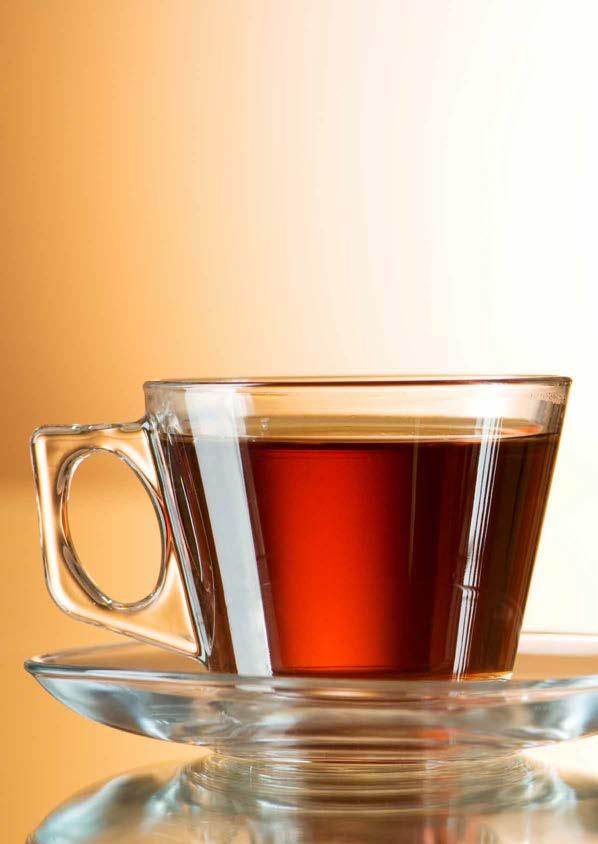
FOR AFRICAN BRANDS – AND, indeed, brands in any emerging market – one of their challenges is often to gain international recognition while at the same time fending off bigger and financially stronger global competitors.
Challengers who, it must be said, may also not be averse to the occasional strong-arm business tactic to gain the upper hand. And who may also enjoy political and deep-pocketed support from governments in their home countries.
This can leave African marketers and their organisation’s executive teams in a quandary. Do you spend big money (by
Rivals may usurp your advantage
your company’s standards anyway) in an effort to expand your business and achieve footholds in foreign markets - only to find your strategy and perhaps even the product itself usurped by a rival with infinitely greater resources?
If you have something geographically unique to offer, one of the ways to achieve a measure of protection is through the European Union’s register of
›Workers harvesting the Rooibos plant in the Cederberg Mountains of South Africa.
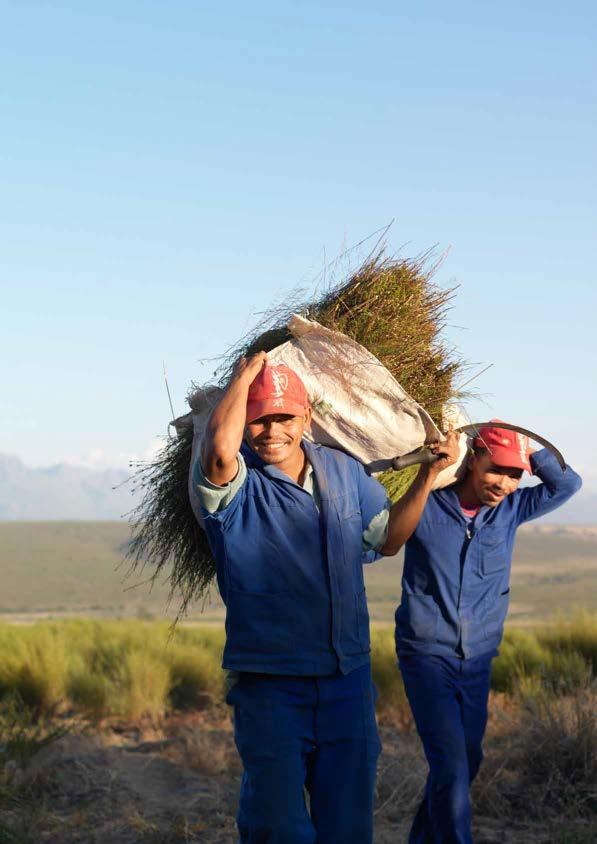
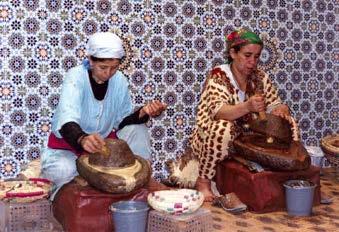
The production of Argan Oil by traditional methods in Morocco.
protected designations of origin and protected Geographical Indications, commonly known as GI.
Well-known products that have achieved GI protection include Champagne (from the region of the same name in France), Irish Whiskey (whiskey from Ireland as opposed to whisky from Scotland and the many other nations that produce the amber spirit), and Port wine (the Portuguese fortified fine that originates from the region around the city of Porto).
If the products don’t come from those designated areas, they can’t be called that. Simple … and potentially of great value when it comes to setting your brand and product apart from the rest of the not-so-authentic pack.
AFRICAN FIRST FOR ROOIBOS TEA
Recently, Rooibos tea from South Africa became the first African name on the GI register and, depending on how successfully it can now be leveraged as a unique global brand, it could become a forerunner for other African products to be listed – ranging from tea to coffee, honey and vanilla.
Some experts believe the listing will only have practical benefit if Rooibos can be clearly branded as a distinctive, quality South African product. Given that rooibos has developed a huge international market as a generic product like kiwi fruit, for example, this may be challenging.
And unless African countries can move quickly to protect their similarly distinctive agricultural products, they may find themselves in the same ‘generic’ trap that is enormously difficult to reverse at a later stage.
Even if a GI listing is achieved, competitors from outside the Geographic Indications area won’t necessarily take the situation lying down.
Jeremy Sampson, Managing Director of Brand Finance Africa, part of the international brand valuation consultancy, relates how in 2015 the Spanish smuggled the equivalent of 10-million bottles of their wine into France to be bottled. This ‘Frenchification’ enabled them to earn a premium of double to triple the value due to the ‘Bottled in France’ labelling. That’s essentially what getting GI protection aims to prevent.
The ‘generic’ trap may be irreversible
GEOGRAPHICAL INDICATIONS: THE AFRICAN OPPORTUNITY
According to a 2020 European Commission study, Europe’s economy gained about €75-billion in 2017 from GI products, with the sales value of GI products doubling on average, when compared with similar products without GI certification.
Clearly then, GI certification holds considerable opportunity for a predominantly agrarian Africa, should the continent protect its rights and adopt this strategy. The second phase of the African Continental Free Trade Agreement (AfCFTA) focuses on intellectual property rights and trade – already one step towards recognising the economic value of GI.
Any number of African countries have distinctive products – known for unique characteristics like aroma, flavour, and the traditional knowledge systems used to make them (known as ‘terroir’) – and they would do well to closely monitor Rooibos as a case study.
Ethiopia produces some of the finest coffees in the world, for example, having unique flavours and aromas from the country’s Yirgacheffe, Sidamo and Harrar regions, as does Cameroon with its Oku white honey. The Ijebu people of western Nigeria call their processed cassava Ijebu garri.
Yet these premium products sell internationally at only a small premium to less distinctive products, and only a tiny percentage of the retail price goes back to the home country.
According to a World Intellectual Property Organisation (WIPO) report a number of countries or producers have embarked on a process of protecting and managing GIs, including:
• Ethiopian fine coffees • Moroccan Argan oil (which grows in no other county in the world) • Kenyan tea and coffee • Ugandan vanilla, and • Oku honey of Cameroon.
“Moreover, there are ongoing programs that show the growing awareness of the significance of protecting and managing Geographical Indications. These include WIPO-supported Zanzibar Clove, Tanzanian Arabica coffee and Ugandan Cotton projects,” the WIPO report states.
Otherwise, African countries presently do little to protect GI and capture intangible assets. So far, only Zimbabwe and South Africa have Geographical Indication Acts, with the latter having set up a GI registry and guidelines to protect GI agricultural products. Areas in Africa with terroir of worldwide renown, such as the Sahara and Kilimanjaro, are having those labels appropriated anywhere in the world for blends or their products, similarly to rooibos.
PHOTOS: PIXABAY, CHRUMPS VIA WIKIPEDIA, PEQUOD76 VIA WIKIPEDIA, GERHARD G & SUPPLIED
A ROOIBOS CASE STUDY
South Africa’s rooibos tea (before it became Rooibos with a capital ‘R’) has gained a vast international market as a health drink, but until now there has been no control over its origins or quality.
In June, Rooibos was notified that the European Commission had approved the registration of the designation ‘Rooibos’/’Red Bush’ in its register of protected designations of origin and protected GIs. Rooibos is the first African food to be approved by the EU for listing on the register.
Dawie de Villiers, SA Rooibos Council director and managing director of a Rooibos-processing and marketing company, explains that while the award is extremely welcome, the GI must still practically be exploited to realise value for the product via education and marketing efforts.
Rooibos is today directly sold in volume in over 50 countries and makes its way into many more, riding the wave of healthy drinking. The biggest markets by volume are Germany and Japan, followed by the Netherlands, UK and US.
De Villiers points out that GI is but a first step – after all, it is not protection for the entire world, only the EU (albeit the biggest market for Rooibos outside South Africa). The EU GI protection is the culmination of a decade’s effort, a process which is now being replicated in the rest of the world and means South Africa owns the name ‘Rooibos’ and the product associated with the name.
Sampson describes the importance of the GI registration as being the potential to earn a premium, as people attribute quality to the geographic location.
“There may be many people using the rooibos name because they have been allowed to do so quite legitimately – and this has to be unwound. Once you have the name secure, you have to enforce the integrity of it. Then it has to be built into a recognisable and guaranteed premium brand, before it can be taken further,” he explains.
Sampson is of the view that all, or many, similar iconic African brands should be following the Rooibos example – in the case of South Africa, particularly the renowned Western Cape wine producers. He gives the example that a food category as broad as Welsh lamb has been registered – and Karoo lamb (also from South Africa) is in the process of applying for GI certification.
“If in doubt, register it,” is the mantra. Even if a brand is only trademarked in the national country, it means you have the first call to enforce it globally, explains Sampson.
Products sell at a price premium
WHICH WAY WILL ROOIBOS GO?
There are two ways the GI registration of Rooibos could go. One is the example of the Champagne brand, where nobody in the world would dare call their sparkling wine Champagne, because it is so well established that the product comes from the defined French geographic location.
The other is Neapolitan sauce, where the Italian region eventually succeeded
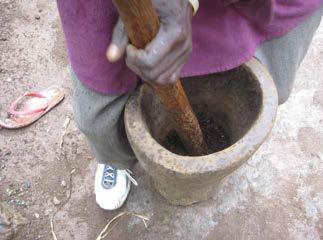
›A farmer grinding coffee near Kilimanjaro in Tanzania. The country’s coffee could potentially benefit from a GI listing.










